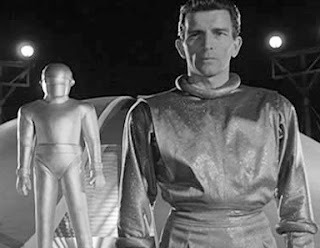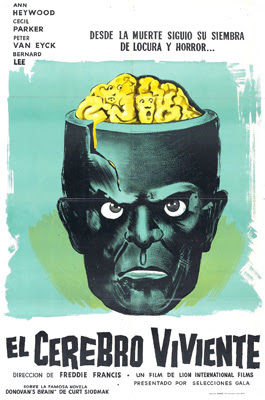For those of you who are new to the blog (and for those who've read a post or two and are thinking, "why does he write about movies no one's ever heard of?"), Films From Beyond the Time Barrier is a salute to the movies I watched in my youth on the old black and white TV, at downtown theater matinees, and at the drive-in (which works out roughly to stuff made between 1930 and 1980). If you peruse the lists of categories and titles to the right, you'll see mostly sci-fi, fantasy and horror, but I also post about mystery-thrillers, film-noirs and even the occasional western.
As much as I love the true classic sci-fi and horror films such as Forbidden Planet and Bride of Frankenstein, far better and more insightful people than me have written a ton of material on these titles, and I could scarcely add anything else to the treasure trove. I prefer to dig up movies that have largely escaped the attention of (or been studiously ignored by) mainstream reviewers and even vintage B movie fans. They tend to be low-budget, black and white occupiers of the bottom half of double bills, with no-name actors and cheap effects. But in spite of their flaws, I find something to like about them -- an unusual plot twist here, a surprisingly good performance there, or just an interesting behind-the-scenes story. Even in this age of ubiquitous online streaming and cheap DVD releases, they're not always easy to find, but perhaps worth the trouble if only to take a break from the unending parade of multiplex blockbusters that come, make their billions, and then get out of town to make way for the next blockbuster.
In honor of the second anniversary, I thought I'd double the action and double the fun with a special double feature post. And then double down again by featuring two of the better and more underrated adaptations of Robert Louis Stevenson's classic tale of dual personality, Strange Case of Dr. Jekyll and Mr. Hyde. According to one source, there have been over 120 film adaptations of Jekyll and Hyde (only Dracula and Sherlock Holmes seem to have inspired more filmmakers). There's been a son and daughter of Dr. Jekyll, a Sister Hyde, and even a blaxploitation Dr. Black and Mr. Hyde. Whatever the variation, our fascination with humanity's dual nature ensures that the good doctor and his cruel opposite will return again and again to the theater, movies and TV.
Now Playing: The Two Faces of Dr. Jekyll (aka House of Fright, 1960)
Pros: Unique take on the Jekyll/Hyde story; Christopher Lee is a convincing good-for-nothing upper-crust sleazeball
Con: Hyde's good looks take the edge off the character
Pros: Unique take on the Jekyll/Hyde story; Christopher Lee is a convincing good-for-nothing upper-crust sleazeball
Con: Hyde's good looks take the edge off the character
We seem to be living in the ultimate Jekyll and Hyde age. Hardly a day goes by without some upstanding pillar of society revealing an ugly dark side on the omnipresent 24 hour news cycle. One by one, once-respected people and institutions fall spectacularly -- Rod Blagojevich, John Edwards, Joe Paterno, the Boy Scouts, Jesse Jackson Jr. -- and always the reaction is the same: "But they seemed so upstanding, so caring, so charismatic…" Mass media keep feeding our delusions, keep encouraging us to conflate appearances with reality and attractiveness with virtue. Then zing -- some new high-and-mighty celebrity gets caught, and the media revel in their depredations and our gullibility. And the cycle begins anew.
Hammer Films' version of the classic tale is a particularly apt one for a society that's so susceptible to pretty faces. Two Faces adds a neat twist, making the good Dr. Jekyll look almost like a caveman with a bushy unibrow and unkempt beard, and turning Hyde into a suave and devilishly handsome member of the upper class. (The tagline: "Sometimes, Terror has a Handsome Face!")
 |
| Dr. Jekyll (Paul Massie) is about to undergo an extreme makeover. |
While sad-sack Jekyll has been immersing himself in his work, his beautiful but no-good-unfaithful wife Kitty (Dawn Addams) has been stepping out with Jekyll's upper crust slacker friend Paul Allen (Christopher Lee). Jekyll is the ultimate cuckold-- Paul has been coldly hitting Jekyll up for handouts even as he's been carrying on with his wife. When Jekyll takes his serum and frees the Nietszchean superman in himself, the dashing, blonde, blue-eyed and clean shaven Hyde visits a bawdy music hall and promptly discovers his wife and friend together. In between beating up the lower class locals, assignations with exotic dancers, and general mischief and depravity (not to mention fighting off Jekyll's personality trying to take back his body), Hyde concocts a scheme to cover the incorrigible Allen's gambling debts in exchange for Kitty's favors. As Hyde's depravities begin to catch up with him, he devises yet another plan to suppress the Jekyll part of him for good.
 |
| Mr. Hyde looks forward to a night on the town. |
Two Faces is one of Hammer's better non-Dracula/Frankenstein remakes, and boasts one of Chris Lee's better non-Dracula performances for the studio.
Where to find it:
Oldies.com
"Here is the century-old horror classic filmed as it has never been before!"
Now Playing: The Strange Case of Dr. Jekyll and Mr. Hyde (TV movie, 1968)
Pros: Bravura performance by Jack Palance; Authentic production design
Con: Shot on videotape
Pros: Bravura performance by Jack Palance; Authentic production design
Con: Shot on videotape
Strange Case is a more straightforward retelling, although it still takes liberties with the source material. All the familiar elements from Stevenson's story and earlier film adaptations are there: the hostile reception by his medical colleagues to Jekyll's theories; the drinking of the potion and the agonizing transformation; Hyde's savage beating of an unarmed gentleman with his cane; his possessiveness and terrorizing of an attractive dance hall girl; the suspicion of Jekyll's friend and solicitor that Hyde is blackmailing the good doctor; and Hyde threatening to permanently take over Jekyll's body as the supply of reverse potion runs out.
 |
| Dr. Jekyll (Jack Palance) hesitates before drinking the potion for the first time. |
Palance also hits just the right notes as Jekyll (which is not necessarily easy, as Palance looks pretty intimidating even as the refined Dr. Jekyll). The character traces a sort of bell curve through the film-- anxious and under attack by his colleagues at the beginning, intoxicated by Hyde's perverse joie de vivre in the middle, and worn out and hopeless at the end. He is a true addict. At one point, he tells his friend Devlin (Denholm Elliott), "Hyde has no hold over me. Whenever I want to get rid of him… [downs the rest of his drink] … I can do it just like that." Spoken like a true junkie.
 |
| Mr. Hyde has his sword-cane ready for muggers and other assorted London low-lifes. |
There's one bit of business that's almost a throwaway, but adds to the authenticity of the Victorian London setting and is chilling in its own way. As a constable walks along the darkened street, he looks up at a lighted window, from which a woman's screams are emanating (Hyde is beating his dance hall companion). He pauses, then vaguely smiles and walks on. No prosecutions for domestic violence in this Victorian-era London!!
Dan Curtis of Dark Shadows and Kolchak: The Night Stalker fame produced. Fans of either or both will immediately recognize the signature soundtrack. I was a big Dark Shadows fan at the time, and I remember counting down the days to the debut of Curtis' Jekyll and Hyde on network television. I wasn't disappointed. The Emmy's were similarly impressed that year, giving it 4 nominations, including Best Dramatic Program. It's held up remarkably well, and is worth tracking down.
Where to find it:
Oldies.com
"It has been said that many men have found their way from the valley of violence to the palace of wisdom. But if all men must learn wisdom tomorrow from violence today, then who can expect that there will be a tomorrow?"












